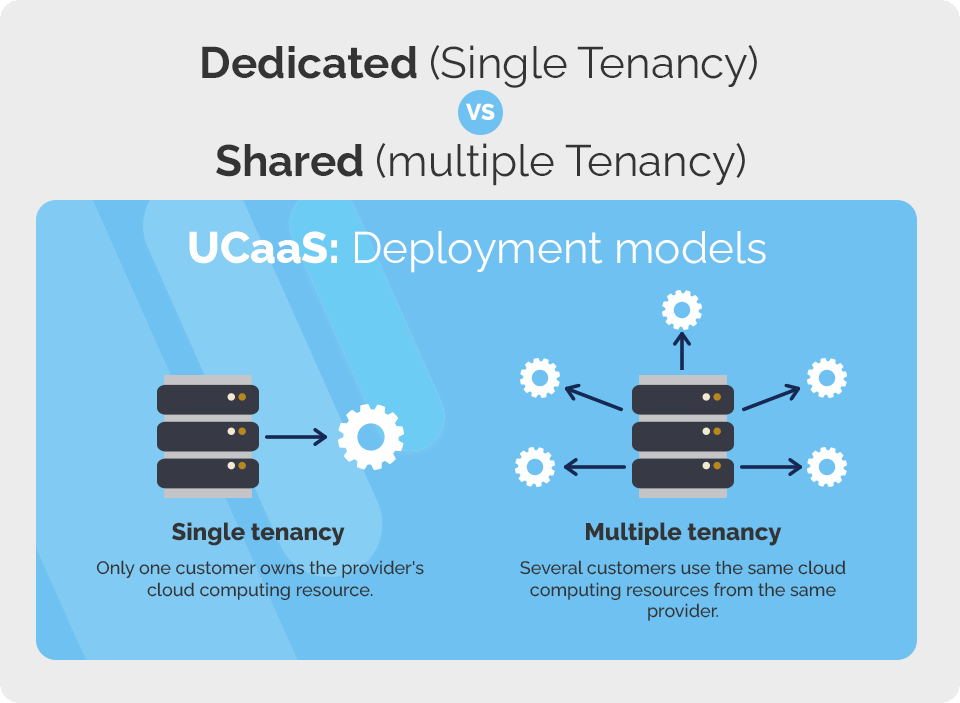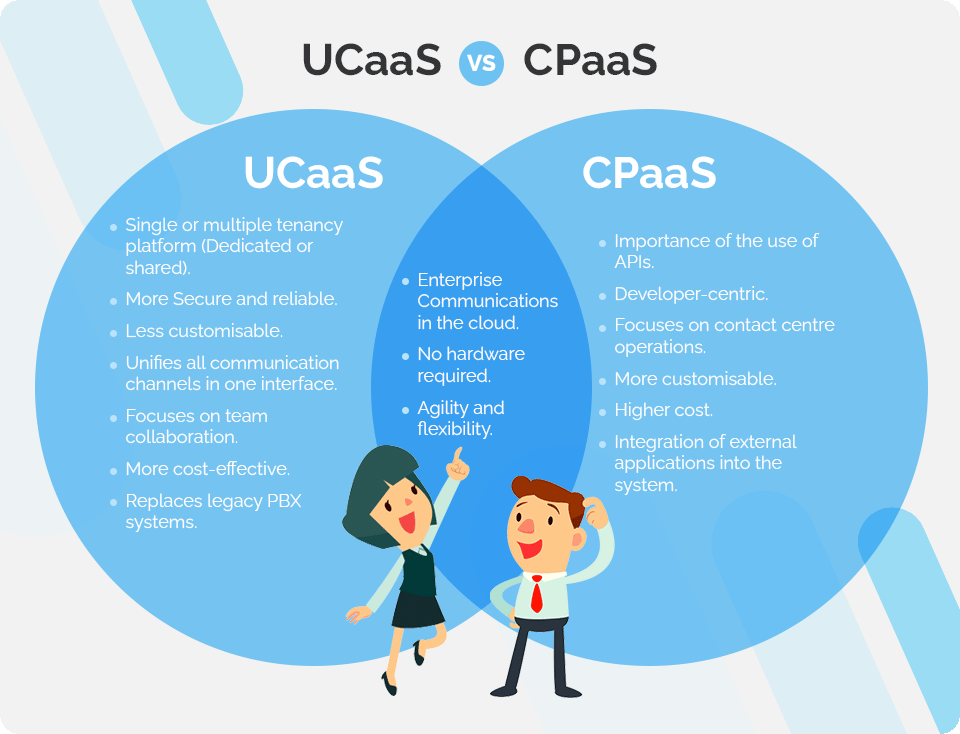
Table of contents
UCaaS (Unified Communications as a Service) is a communications service model that emerged in 2014, coupled with the rise of the Cloud Computing movement.
Since then, many companies worldwide have adopted this model to revolutionize their communications inside and outside the organization. The reasons are many, from cost savings to increased productivity to improved customer relationships and sales.
The evolution from traditional fixed telephony systems to UCaaS services has enabled companies to offer customers, suppliers, and staff more and better communication channels.
UCaaS systems have also evolved to meet user demands, especially in collaboration and remote working, following the situation due to the COVID-19 crisis in 2020.
UCaaS: Definition
According to Gartner, Unified Communications as a Service (UCaaS) is a cloud-based unified communications model that supports six main features:
- Enterprise telephony.
- Conferencing (audio, video, or web).
- Unified messaging.
- Instant messaging and presence.
- Mobility.
- Integration of communications in business processes.
These functions, however, have evolved, and today they are complemented by others such as:
- Shared desktops.
- Virtual backgrounds.
- Integration with other business tools.
- Automatic transcriptions.
- Automatic translation.
All these functions must be supported by an easy-to-use system with high-quality audio and video. Such a system requires fast communications networks with low latencies and a high capacity to support multiple devices and applications connected simultaneously.
Evolution of communication systems: from telephone to UCaaS
Since the invention of the telephone in 1846, in 100 years, there have been few significant advances in how businesses communicate.
While it is true that the first cordless telephone came into service in 1946, its use was very restricted as it required external antennas and huge batteries. In 1966, the first Xerox fax machine made it possible to send copies of documents over a telephone line. However, its cost was prohibitive.
It was in the 1970s when the first companies began to have their first private branch exchange (PBX) networks, which allowed them to handle a large number of calls without the need for telephone operators or with a minimal number of them. The invention of tone dialing also made it easier for users to use PBX services, introducing prerecorded messages to create voice menus.
However, with the advent of mobile telephony, the introduction of SMS in the 1980s, and the first touchscreen mobiles in the 1990s, business communications made some significant progress. But the real revolution came with the popularization of personal computers in the 1980s and the Internet in the 1990s, which changed how companies communicated for the next 20 years.
Since then, new channels and means of communication have revolutionized society and the economy:
- More advanced telephone systems.
- The arrival of email, a real milestone in communications.
- Instant messaging applications and video chat.
- Thanks to the rapid advance of mobile telephony, the possibility of being permanently connected in multiple ways.
- The rise of social networks.
All this deployment of systems, channels, and technologies, and the difficulty that companies were beginning to have in integrating and managing them efficiently, quickly led to the appearance of the first unified communications systems (UC). The term appeared in the mid-1990s when messaging and real-time communications began to be combined.
Unified communications in the cloud (UCaaS) first came to prominence in 2014, on the heels of the cloud computing movement. This approach shifts the previous model, in which companies purchased and deployed their own communications infrastructure, in favor of a service provider model. The service provider invests in a virtualized data center without the need for the enterprise to do so, and offers a more flexible consumption model.
UCaaS Deployment Types
There are two main types of UCaaS architecture to choose from: single-tenancy and multi-tenancy.
With a dedicated platform, also known as single-tenancy or multi-instance, the enterprise receives a custom-built software platform that can integrate with existing on-premises applications.
This model is considered more secure and reliable, as it is more private and each customer’s data is stored separately. Depending on their needs and demands, different customers get their own customized software and share only the hardware. It is the most popular mode regarding security, reliability, and customization.
In the multi-tenancy model, companies share a single software platform and the associated hardware. This mode is considered more cost-effective, with more support and redundancy. The software instance is hosted in the UCaaS provider’s data center, and the provider delivers software updates. However, it is less customizable and flexible than a single-tenancy deployment.
Changing internal coding or customizing software features is not an option here. Everyone shares the same cloud capacity and resources.
Even with less flexibility and lack of customization, the shared model has a huge fan base because it is more cost-effective, requires minimal maintenance, provides better vendor support, and delivers automatic notifications and updates to your systems.
In addition, a hybrid approach is also possible. In this case, the company keeps some of its communications on-premises and some in the cloud. These decisions are usually made for security reasons or while migrating traditional PBX systems to the cloud.
UCaaS and CPaaS: What’s the difference?
If you’ve heard of UCaaS, you may also be familiar with the term CPaaS. Often the two terms can be easily confused because they both focus on deploying enterprise communications. So what’s the difference? To explain this, we need to understand how each one provides services to its customers.
In a nutshell, a Communications Platform as a Service (CPaaS) is a cloud-native solution that allows you to add communications capabilities to any software application. To do so, CPaaS uses APIs (application programming interfaces) that developers can use to integrate any communications platform with their own software to enable specific capabilities, such as sending SMS, voice, or video.
Therefore, in UCaaS, all functions and applications reside inside the platform, while CPaaS systems have a more open approach that allows each customer to build their own communications model.
Currently, both systems are beginning to converge, with some UCaaS providers incorporating APIs into their platforms that allow custom integrations with CRMs and other business applications.
Advantages and disadvantages of UCaaS solutions
UCaaS platforms offer companies significant competitive advantages, reducing the number of tools, devices, and applications and, therefore, the cost of their acquisition, management, and maintenance.
In addition, integrating all channels helps improve productivity, remote work and collaboration, and the relationship with customers and suppliers.
Some of the main advantages of UCaaS solutions are:
- It reduces costs by consolidating different tools into a single platform.
- Reduces ownership costs compared to, for example, local PBX systems.
- It is a much more scalable system that adapts to the company’s needs at any moment.
- It reduces the workload of IT departments since the provider is responsible for the platform’s maintenance, updating, and security.
- Improves communication and collaboration within the company and productivity in general.
- Facilitates employee mobility.
- Improves the relationship with the customer, providing a more fluid and universal communication experience with the brand.
- Improved security thanks to centralized device management.
On the other hand, the main disadvantages of these solutions are:
- High dependence on high-performance Internet.
- Change management and migration cost.
- Potential security and confidentiality risks.
- Limited interoperability with existing systems.
However, nowadays, most UCaaS providers, such as VoIPstudio, offer solutions that address these potential problems, from integration with applications to security mechanisms at the highest level.
Steps to implement a UCaaS solution
While UCaaS solutions are generally aimed at all types of businesses, it is essential before starting a deployment or migration process to make sure that it is the type of solution you need and that there is a provider that meets all your expectations.
Some of the most critical issues to consider are those related to Internet infrastructure and security requirements. However, as we have seen, these aspects are usually solved with the technologies of today’s UCaaS providers.
Another important aspect is cost. Although being a cloud solution usually means a significant initial cost saving in licenses, hardware, and devices, you must take into account the monthly fee of the service, as well as the communications needs and the cost of migration (change management, training, etc.).
Be sure to confirm with your provider all licensing and usage costs, as well as possible additional charges for premium features, the cost of calls and phone numbers, etc.
Choosing a provider
To choose a provider that fits your needs, we recommend you first review your internal and external communications needs.
Analyze the different communication processes of your company’s staff, both between employees and departments, as well as with customers and suppliers.
List the channels required (telephone, chat, videoconferencing, etc.). This moment may be an excellent time to update your communication processes, incorporating, for example, new communication channels with your customers.
Document all these processes so that you can analyze whether the chosen platform supports them, and it will also be easier to plan and execute the subsequent migration process.
Remember that a UCaaS system must adapt as much as possible to your processes and needs and not the other way around.
When selecting your provider, we recommend you look at all the functions it offers. Remember that many of them offer features you do not need, which can sometimes involve an extra cost or greater complexity. For example, if you don’t need video conferencing with customers or suppliers, don’t focus on that functionality.
Some providers, such as VoIPstudio, offer you free, fully functional trials, which allow you to evaluate in the field if they can solve all your needs. Take advantage of it!
In addition, we recommend you look at the most important software directories and review sites in the industry, such as Trustpilot, Capterra, or G2. There you will be able to see genuine reviews of companies like yours.
Finally, test the support service and the response they give you. If you don’t have any specialists in this area in your company, you may need help setting up your platform and getting the most out of it. Again, if the vendor offers a free trial, it will be a great time to test their support service.
Future of UCaaS: trends for 2023
When we talked about UCaaS evolution in history, we saw that these systems have been adapting quickly to the new communication channels that have been appearing. They have also taken full advantage of emerging technologies to achieve universal, mobile, collaborative, and more efficient communications.
UCaaS systems are growing rapidly and play an essential role in digital transformation processes. In this situation, UCaaS service provider companies are working on improving systems in different areas, such as security, interoperability, or the incorporation of AI to improve workflows.
In this sense, AI will allow, for example, better performance in noise suppression and voice recognition, as well as functions such as real-time translation and transcription, automatic creation of meeting summaries, or biometric recognition (facial or voice) for secure access to online meetings or interaction with systems, for example.
Improved AI will also enable the use of more intelligent bots, capable of communicating more autonomously and naturally and providing solutions for the different needs of their speaker.
On the other hand, the new communications networks, especially 5G wireless technology, will substantially improve the experience of UCaaS users, as it allows higher speeds, more capacity, and less latency in the network. Thus, it will be possible to provide services that demand more network resources in real-time and for multiple devices simultaneously.
More from the blog
Want to improve your business communication?
Unlock enterprise-class call center power at affordable prices – no hardware, no delays, no surprises!









